- Would you begin by telling us about the make-up of your Kuromori Kagura troupe in and what professions they come from?
- We have 15 active members. The youngest is in his fourth year of college and the oldest was born in 1934 and is now 77, so, it is quite a span, isn’t it? Everyone has their regular day jobs, some are in the primary industries of fishery, farming and livestock raising, and others are company employees or civil servants. I was born and raised locally here in Otsuchi, went to university in Tokyo and then returned here, where I work now in the prefectural office as a civil servant.
-
How did you first encounter Kuromori Kagura?
My family home in Otsuchi has long been a “kagura lodging” that provides lodging for the touring kagura troupes, so I was watching it from childhood and came to love it. The house that is the kagura lodging would invite the “ Gongen-sama ” (the symbol of the deity of the Kuromori Shrine in the form of a lion’s head brought by the kagura performers) to their home and the people of the local community would gather to enjoy the ritual dances and music. But, they must also provide food and lodging for the dozen or so people of the kagura troupe. This meant that they had to be houses with considerable financial means, so we are told that it was usually local landowners or leading families in the community. In the case of my family, we had long run a company in the local fishery industry. The name of the fishing ship our family owned was Kuromori-maru, based on a story that one of our boats in the past had picked up a wooden panel engraved with the words “Kuromori Shrine” afloat at sea.- What was your impression of Kuromori Kagura as a child?
- It really looked to my eyes as a child that a deity had appeared in front of us. It was so exciting and made me feel, “Wow!”
- After that, how did you go on to become a kagura performer as an adult?
- There is a now legendary kagura dancer named Hironori Saeki who taught our young generation of kagura members before his sudden death at the age of 39. I am told that one time when he came with the troupe to perform at our home, people in the community told him that I, the son of this kagura lodging, loved kagura so much that everyone felt sorry for me, so wouldn’t he take me in and teach me to perform kagura. I guess when he heard that he felt a responsibility to teach me. That night when he stayed in our house, he said to me, “Do you want to try dancing?” and put me through some basic steps. That was the start for me. I was in my second year of high school at the time (age 17).
- Did other members of your kagura troupe also see kagura when they were young at places where the troupe toured? How did your other members become part of the troupe?
- One member says his uncle took him to see kagura when he was still in nursery school. Another is a rare example of someone who was going to see kagura and imitating the dances from the age of his earliest memories, and he was already going along with the troupe on tour when he was in his first year of middle school. Most of our older members began kagura because they had relatives or family members who were kagura troupe members. But, with most of the younger members who join Kuromori Kagura today, it is not a matter of family tradition. They are people who come from other regions where they were involved in other traditional folk performance like Nenbutsu-kenmai (Buddhist prayer sword dance) or Nakano Nanazumai (Nakano seven heads dance) come.
- Is there any kind of ritual involved when a person officially becomes a member of your kagura troupe?
- No, there isn’t. Long ago, when a person became an apprentice under a kagura master, they would exchange vows while drinking water together from a sake cup. You might say it was similar to the way a young gangster makes his vows when joining a gang (laughs). But, we don’t have any kind of ritual like that today. It is just a matter of once the person has learned the techniques of the dances, we begin taking him along on the tours.
- Your current kagura troupe has seven members in their sixties and older and seven skilled young members in their twenties and thirties, which seems to be a good state for a troupe. On the other hand, we hear about other kagura or traditional arts that are in a state of crisis due to a lack of young people to carry on the arts. Did Kuromori Kagura also go through a period like that?
- Of course there was. In the decade after around 1975 there were not enough members and the annual tours were not made for about six years. With the trends of urbanization and the aging of the society at large, things are quite difficult.
Before the establishment of the Kuromori Kagura Preservation Association in 1983, the leader of the touring troupe would select and gather members for each tour. People from a wide area of the Rikuchu Coast where the troupe toured would join in as members, and in the decade after 1955, there were seven districts in Miyako city alone that had rites of festivals [where traditional dances like kagura were performed], including Akamae, Kanehama, Nagasawa Orikabe, Yagisawa, Ushibushi, Omoe (Kurosaki Shrine) and Tsugaruishi (Komagata Shrine), from which people who were skilled at the dances could be selected. In the old days, being selected to join the Kuromori Kagura troupe was probably an honor about as prestigious as being accepted to attend university.That is proof of how many people wanted to perform kagura in the old days, and rather than being a case of having to teach the younger generation in order to preserve the art, it was a case of people being so anxious to keep their place in the troupe that we hear stories about ones who hid the costume of the role they wanted to keep so that no one else could dance it. Today we can’t afford to do things like that. Whenever we find someone who has an interest in Kagura we have to invite them in and teach them the art. At present we are managing to keep together a viable troupe but all of us have different day jobs and families, so we all have to make special efforts to continue. Doing kagura requires a good amount of time, and for people like me who are in our child-raising years, it is difficult.- If you found a young person who seems to have the qualities required to become a kagura performer, would you want him to join the troupe?
- Of course I would, because we need to keep adding members. The troupe may be in a good state now, but we have no members in their forties, so we get worried when we think about what will happen in the near future. It isn’t simply a matter of teaching someone because we need the members, and we can’t just say, “Here is 10,000 yen, learn this dance.” The person has to love it and come to us asking to be taught of their own will, otherwise they won’t stay with it.
- Since all the kagura troupe members have their own occupations now, so the tours are only done on the weekends, but in the old days up until about 1935 we hear that they would tour all week, staying in inns along the route.
- Yes. It was common for the father of the house to be gone touring for three months at a time. Since they did receive some payment for their performances, I imagine that their wives resigned themselves to the absence because it was a form of work that brought income. And, unlike today when the touring starts from the 3rd of January, in the old days it was done in the off-season from farming, after the rice harvest was finished in autumn.
- Would you tell us something about the history of Kuromori Kagura touring.
- Normally, each town or village had their kagura based on their own Gongen-sama (symbol of the deity of their local Shinto shrine) kept by the local yamabushi (mountain priest and shrine keeper) and that kagura could only be performed within the area, called a kasumi , that the priest was granted right for. However, from old texts we know that the lords of the Nambu Realm (the Edo Period feudal fiefdom in what is Iwate prefecture today) gave Kuromori Kagura the right, in the form of a written license, to tour outside their own area into the turf of other priests and shrines in the region. As evidence of this, we still have the saying today, “Kuromori across the realm, Yagisawa its eight stops,” meaning the kagura of the Yagisawa district of Miyako city could only be performed in its own eight villages, while Kuromori Kagura could tour throughout the [Nambu] realm. This is clear evidence of the special status Kuromori Kagura enjoyed from olden times.
However, the history of Kuromori can also be seen as a history of trials, because local yamabushi priests around the area were constantly filing suits against the Kuromori troupe for performing in their turf. In response to these suits the Kuromori troupe would present their license from the Lord of the Nambu realm and answer with the phrase, “From ancient times we have toured through the three counties of Noda, Miyako and Otsuchi.” Kuromori Shrine also enjoyed the patronage of the lords of Nambu Realm and the Gongen-sama of the shrine had a spiritual following of believers over quite a large area even before the establishment of the Nambu realm’s government. It is probably because if the kagura came to fishing villages and performed the rituals asking the deity for a successful catch and there would indeed be big catches, then the Nambu lords could get tax income as a result. So, considering that Kuromori Shrine is just a small local shrine, I believe it is quite a rare case that so many Gongen-sama would be handed down from olden times and it should be mentioned in old texts from the Edo Period (17th and 18th centuries and first half of the 19th century).- How do you perform rites on a kagura tour?
- The season begins on January 3rd with a ritual dance at Kuromori Shrine. We call it Kamioroshi (invoking the deity of a shrine to “descend” into the presence of the people), and it involves the head priest of the shrine reciting a prayer to the deity of the shrine, after which the kagura troupe does the “Gongen Dance” using the Gongen-sama (the carved wooden avatar in the form of a lion’s head). This dance invokes the deity of the shrine to enter the Gongen-sama, which is then taken on the tour of ritual dances around the region.
When we go to a village that has a “kagura lodging” house, the first thing we do is what is called Kamidashi (invoking the deity to emerge), in which the Gongen Dance is performed before the deity or the shrine of that area as a form of greeting in respect. Also, before entering the kagura lodging the Gongen Dance is performed in the yard outside the house and a rite called Shittogi Maikomi is performed, in which an usu (a large wooden mortar used for pounding rice cake [ mochi ]) is set up in the yard with shittogi (rice flour mixed with water) in it, and a spot of shittogi is placed on the forehead of each of the people gathered as a good-luck charm (and a charm to ward off evil). Then the people of the neighborhood gather at the house in the evening for a “night kagura” performance. The next day, when we leave the lodging we first perform the Gongen Dance in the house, snapping the teeth of the Gongen-sama lion’s head and a gesture of thanks in front of the kitchen, the tokonoma alcove, the household Shinto alter and Buddhist alter. Finally, A Maidachi rite is performed to protect the health of the people of the house before leaving.- Could you give us a short explanation of the rites performed with the Gongen-sama.
- In the Mi-katame (body firming) rite to protect the health, we have the person receive a “bite” from the Gongen-sama on the head and pray that sickness be warded off. In the Hashira-katame rite, a pillar of a newly built house is bitten by Gongen-sama a prayer said for its safety. There are other rites as well, including the Kagura Nenbutsu (kagura Buddhist prayer performed by snapping the teeth of the Gongen-sama in front of a household Buddhist alter or mortuary tablet, and a Haka Shishi rite performed in the same way in front of a grave as a prayer for the deceased. There is also a rite for the safety of boats, and on request, we are told that there have also been rites performed for stables. I believe that the variety of rites performed is another unique aspect of Kuromori Kagura. There are rites for the various milestones in life. When people marry and build a house there is the Hashira-katame rite, when they grow old and pass away there is the Kagura Nenbutsu . I believe that Kuromori Kagura remains important to the people today because it is in this way a kagura so closely involved in the lives of the people.
- Would you tell us about the variety of dances performed in Kuromori Kagura?
- There are about 70 different dances that are recorded in texts. They begin with the Uchinarashi which is a Kamioroshi ritual dance to invoke the deity. Then there are the important dances called Yaku-mai (role dances) that must always be performed, including Sakakiba (performed with a branch of sakaki leaves), Yama-no-Kami-mai (mountain deity dance), the Ebisu-mai (a dance of the patron deity of fishermen, Ebisu) and others. Then there are the Mikagura (Imperial Kagura) based in myths about the gods such as Iwato , and there are humorous “Kyogen” pieces that are performed between the dances as comical interlude. The “night kagura” performed at the kagura lodging is about four hours long with a break for dinner, and it consists of about 10 dances.
- What is the first dance that beginners learn? Besides the dances there is also taiko drum, flute and gong accompaniment, What do you learn first?
- We don’t learn flute and drum. The basic training begins dance. The first thing we learn is Sakakiba with its the vigorous spins and jumps that only younger performers can do. Then we learn the most important prayer dances, Yama-no-Kami-mai , and then the Ebisu-mai dance. It depends somewhat on the person, but to get from Sakakiba to Yama-no-Kami-mai usually takes about three years of training.
- To go from Sakakiba immediately into Yama-no-Kami-mai sounds extremely difficult.
- In the case of Kuromori Kagura, I believe this is where the one who are going to succeed as kagura performers were sifted out from those who wouldn’t. In the past, there were many people trying to become kagura performers, so I believe the training was made intentionally severe as if to say, “If you can’t do this, you won’t be taken along on the tour with the troupe.”
- Does everyone in the troupe also have to be able to perform the flute and gong accompaniment, etc., as well?
- We don’t usually take time learning the gong. The gong is played as a secondary responsibility of the dancers, and it is also played by elderly members who are too old to perform the dances anymore. The flute as well is something that we pick up as we are learning to dance and as we watch.
- I have heard that the taiko drum is also extremely important as the lead instrument. How do you learn to play it? The rhythms of the dances are very complex. Do you just naturally absorb them by listening to them from childhood?
- When we learn the dances, we keep the beat vocally, saying dego-den , chaka-chaka-cha , chaka-chaka-cha as we dance. In this vocal beat-keeping, the sound den is the drum beaten with the right hand on the right side of the drum, ko ( go ) is the left hand beat and chaka-chaka is hitting the rim of the drum. So, if you learn the vocal beat-keeping you basically become able to play the drum accompaniment.
- It is similar to Korean samulnoli and the like, isn’t it? All the performers play the drum and flute and dance.
- In kagura we perform a dozen or so pieces in one night. There are costume changes to be made in between dances as well, so it is virtually impossible for the same dancer can’t keep dancing through them all. So after doing a dance the first dancer will shift perhaps to the drum and the person who was on the drum will go to change into the costume for the next dance, or such. In this way, the roles are put together to get us through the full program. Since the number of members in the troupe that we tour with is not large, it is very important that each person has the ability to perform several roles, so that we can get through the performance smoothly.
- When and how do you all practice?
- We don’t have regularly held practices where everyone gets together in one place at the same time. There may be a few times in a year when we get together to work out a dance that hasn’t been performed in a while, but the basic training and preparation for performances all happens between a master and his apprentice(s). It was true in my case as well, where my teacher, Saeki-san taught me the basics of the dances one-on-one. In the old days, the apprentice would take a fan and go to the home of his teacher to practice. Today, as well, we will set a time and place on a Saturday or Sunday in the summer when I will go and teach the younger performers. Once you learn the basic sequences, the detail parts can be learned at one time or another as necessary, so there isn’t really a need to set dates to practice regularly.
Once a young performer has been studying for five or six years, it is then time to begin learning to use the Gongen-sama in the ritual Gongen Dance. In the meantime, they learn to do a variety of other tasks. When we are out on tour the younger members will begin making the shittogi rice gruel as soon as we arrive at the kagura lodging, and the next morning they will rise first and make preparations like changing the offerings for the Gongen-sama and other jobs. So, in this way they learn not only to perform but also to carry on the customs of the kagura tour, and that is an important part of touring. In that sense, the great amount of time spent on things besides the kagura is actually very important. These are things that can’t be learned if we don’t go on tour. If we are only gathering an hour before the performance and then go home after it is finish, we don’t have much time spent together as a troupe. Especially considering the fact that we all live in different localities, The long hours that we spend traveling, eating and sleeping together as a troupe is the good thing about touring, and that aspect is surely what has give kagura the form it has today. You don’t become good kagura performers if you don’t share the same pot of rice together on the road.- In today’s context it is as if you are together on a study/training retreat the whole time you are touring, isn’t it?
- Exactly. It is like an intense training camp or retreat. In Kuromori we have the spring festival that starts from April 29th, and then there are the summer and autumn festivals, so we have quite a number of performances in the course of a year. But, the kagura tours are different. It is on the pilgrimage-like atmosphere of the kagura tour that the spirit of kagura is communicated on to others.
- Is there something like a manual for the dances of kagura?
- You might call it a text, but there is a book with the recitation text and scripts that I made myself. There are also recitation texts that have been handed down from olden times, but they are written in old language that people today can’t read at all without phonetic transliteration for the Chinese characters. For example, the same character may be read either as ue or kami , so if you don’t learn the correct reading the meaning can change. Knowing that this presented a big problem going forward, I began writing my contemporary-language text when I was in college and finally managed to finish it after returning home. I struggled over the old texts trying to figure out the meanings, so it took a long time to complete my book. Having personally gone through the struggles of losing my own teacher before I had really completed my apprenticeship, I wanted to leave a text that people could look to for some kind of answer when there were in doubt about something. It is sort of a little bible that people can take along on a kagura tour to help them through the things they need to do.
With this text you can study the recitations and scripts at home, So, I have given it to our young members and told them to study from it. I constantly tell them that as a kagura troupe it is embarrassing if we can’t answer the requests that people at the kagura lodgings may make on the spot.- Who makes things like the props and costumes?
- The things that we can make ourselves we do. I make the ceremonial eboshi hats and other props. The Gongen-sama and masks used in the dances are made by a craftsman in Taro. There is now only one person who carves the masks and Gongen-sama and only one person who mounts the drum skins, and they are both well on in years now, so it is a serious concern for us. The masks aren’t things that wear down in use, so there is rarely a need to make new ones. Originally the lion heads for the shishi dances are things that are donated by people involved in each region, and when you look at the generations of Gongen-sama that have been handed down, you see that they are all different because of the preferences of the people who carved them. The Gongen-sama we use now is one donated by a carver who added slight variations to one made in 1842 that my teacher Saeki san particularly liked.
- In the kagura lodgings you see old lion heads on display.
- There are some kagura lodgings that display Gongen-sama. In those cases we have our Kuromori Shrine deity “play” together with the Gongen-sama of that house. We do the Gongen Dance with four lion heads. We are fortunate that those homes feel the responsibility to host kagura. We hope that that sense of responsibility is passed on from one generation of the family to the next, but when the next generation becomes head of the house and a son says that his father liked kagura but he doesn’t really care about it, that is the end of it. Even if the house continues to display a Gongen-sama, we can’t go there if they don’t invite us. Kagura can’t exist if there are no host homes to receive it.
- Are the heisoku offerings made of Japanese washi paper with images cut into it made anew each time?
- They are given to the kagura lodgings where we perform, so they must be made anew each time. Since the patterns that are cut into the paper must be passed on, I have included them in the manual I made. We had a lot of trouble in the past because there were no samples for how the heisoku are cut. So, I did a scan of a sample and put it in my manual. You have to use the available technology (laughs).
- In terms of performance direction, do you sometimes introduce new variations to change the performance? Or do you preserve the existing forms as they have been handed down?
- There are parts that must be preserved and parts that can be changed. With regard to the important Yaku-mai (role dances), we do our best to perform them just as our elder members taught us. Most kagura dances are solo dances, so although the forms are set, the differences in movement of the individual dancer or his preferred physical expression naturally produces some differences. For that reason, the same dance may have a different appearance depending on the performer. Dances like the Ebisu Dance also have parts that are performed ad lib, so they may be different today from the way they were performed in the old days.
- Your comic interlude Kyogen performances were full of ad lib and the audiences thoroughly enjoyed them. One that was particularly entertaining was when you were invited to a local Japanese restaurant on your tour to the U.S. and you all started singing an improvised song. I remember how the lines you all sang to the unique clapping beat was full of witty plays on word.
- You mean the congratulatory song, don’t you? Rather than being pure improvisation, there are about 100 different variations that have been handed down. When the person who is leading the toast sings the first line, we all know the lines that follow it, so we all sing in chorus. That time it was a restaurant, so we sang a song wish for the prosperity of the establishment, but the lines were chosen to fit the venue. In many cases the songs begin with temporal elements or greetings related to the season. For example, if it is in the morning, it may start with the line, “This morning the sun shines in golden glory …” that expresses the brightness of the day and goes on to finish with some witty play on words. This type of song is sung at the kagura lodging when the master of the house and main guests gather for dinner and a round of drinks has been poured.
- I would like to ask how you see the senior member of your troupe. Do you feel differences in how they view kagura?
- When our members that are now in their sixties began kagura it was in the days when they were still touring through the week rather than only on weekends. They were the ones who changed the system for us to our present weekend tours in order to answer the changing wishes of the kagura lodges and the needs of the times. There are things that must be preserved, as kagura and as an art, but they knew that there are some things that need to be changed to some extent in order to preserve the tradition of touring kagura. I think it is very meaningful that they created the present form of kagura that the younger generation can carry on.
- The kagura lodgings are surely very important for Kuromori Kagura. But, from now on won’t it be increasingly difficult for one house to host kagura, for economic as well as personal reasons.
- Yes, it will, especially since the tsunami that washed away the lower-lying homes and has forced them to move to higher ground and changed the face of the former communities. In some places it is now the case where you don’t know the name of the family living next to you or where they work. For one home to host the kagura means they have to be able to hang out the bedding to air and being the day before to prepare the meals for the dozen people of the troupe. It is difficult to receive the kagura if the groundwork isn’t laid, such as having a community where relatives and the neighbors will help out. For the kagura troupe it is enough if they just serve us rice and miso soup and pickled vegetables. Just rice balls and a cup of instant noodles is enough, even with the minimum of room and board they say they are still grateful to have a kagura lodging that will receive them. But, for the people offering the kagura lodging it is surely more complex than that, because they will undoubtedly have the feeling that they are receiving more than just people, they are receiving the kagura deity.
What are the grounds for receiving the kagura? I believe that the grounds for receiving it must be growing thinner. In the old day there were more people who were working in the natural world as farmers and fishermen, so when the Gongen-sama came to their village they felt ‘It is the deity!’ and receiving it was a matter of belief, of faith in the deity. But for today’s office workers and company employees, there is probably less of that [spiritual animist] faith and belief remaining.In that sense, there have to be people in the community who truly love kagura or they won’t invite us, so the number of such communities will gradually decrease. To make sure that doesn’t happen, we have to change our methods and our programs and present a variety of dances, etc., in our programs that will show people just how fascinating kagura can be. The kagura tour depends on there being people who want to see kagura and people who are will to offer us lodging, and it can’t continue just on the desire and efforts of us on the performing side. Today there are a growing number of young people on both the viewing side and on the performing side, so I hope we will see them begin to connect to each other. It may sound a bit overstated to speak of nurturing and building an audience, but an important issue for us is how to expand the audience base.- In Japan now, dance has been made a required subject for classes in junior high schools. Do you sometimes go to schools to teach kagura now in those classes?
- When we toured in America and did workshops at nursery, elementary and junior high schools, people in the troupe were saying that we should be doing this in schools in Japan. We need to create a situation where the children of our region get and experience of kagura so that when they become adults and may go off to work in other regions, they will be able to look back and remember that they did kagura when they were in school. Some of our troupe members are going to schools to teach kagura now, but for those of us with day jobs, we simply don’t get that kind of time to teach on the weekdays.
- What are your feelings about being a member of the kagura troupe? Is it a matter of pride, or confidence, or do you feel it is a sort of mission you are bound to?
- I wouldn’t say it is anything as noble as that. How can I explain it? I guess it is a feeling that we must preserve what needs to be preserved. There are aspects of the kagura touring process that need to be changed. But, I believe it is not just the dances. There is also an aspect of the spirit of kagura that we have to preserve somewhere in our hearts as kagura performers. This has to be done properly, otherwise it is really an insult to the people of the kagura lodgings who spend more time and money to receive us.
- Rather than feeling that they are hosting the kagura troupe, the feeling that they are receiving the deity must be stronger. The foundation is a matter of faith, isn’t it?
- Of course it is. When we enter a village, the elderly women in particular open their windows and put their hands together in prayer. In fact, they are worshiping us, the troupe. The prayers or worship we receive is the same as when people pay respect for [Buddhist] pilgrims by worshipping them. Of course, it is the same as worshipping the deity. They worship the kagura people in the same way. And, because we are aware of this faith being placed in us, we have to act in a way that is worthy of people’s faith. For example, even if we are cold standing outside during a ritual, we can’t allow ourselves to complain about the cold. We believe that we have to live up to the people’s faith.
And, for this reason, there is always a sense of relief when we finish a tour and return the deity to the shrine. In that act, we are returning from the extraordinary to the ordinary state of daily life. Our time in service of the deity thus ends. During a tour, someone in the troupe is in charge of caring for the Gongen-sama, and during that time we feel that we are in service to the deity.- Is that spirit something that you are taught by the older members of the kagura troupe?
- It is taught, but not through words. In my case, it is something that I have learned naturally in the process of eating and lodging together as a troupe on the tours. It may not exactly be a case of ‘silence is golden,’ but I feel that rather than being told this kind of thing outright, it is more meaningful to learn it through actions in this way, instead of words.
- One of the members of your troupe on the American tour was from Japan’s northern island of Hokkaido. I have also heard that Kuromori Kagura is performed down south in the city of Kita-Hiroshima, isn’t it? I find it amazing that your kagura has been transplanted to these distant regions.
- They have a strong desire to revive the shrine rituals and the kagura of their own regions, so my teacher Saeki-san went to these places to teach and create bonds through the sharing of water cups, and he also had new Gongen-sama made there. We have had these people learn the dances to some degree by watching videos, and when we went to a festival in Hokkaido to perform, we took some extra time to do some individual teaching.
- Would you tell us about the organization of the Kuromori Kagura Preservation Association?
- The Preservation Association is made up of the Sodai (representative trustee) of Kuromori Shrine and the members of the kagura troupe. The chairman of the Association is the representative of the kagura troupe. In the Edo Period it was not a head priest or a yamabushi priest that was in charge of a shrine, it was a common farmer called a Zoku betto (lay administrator), and now that role goes to a person called the Sodai . The Sodai presides at the Kamioroshi (invoking of the deity) ritual on January 3rd and organizes things like the performances held after that at the Yamaguchi public center. He is also in charge of making the preparations for the regularly held Kuromori Shrine festival in July and the Mai-osame in December to end the year’s kagura tours.
- Please tell us about the Great East Japan Earthquake and Tsunami that struck your region.
- Many of the members of the kagura troupe are fishermen, and since there was no phone service to contact people after the tsunami, I feared that we had lost maybe one or two members. However, we were fortunate that all of our members survived. And the only ones who lost their homes to the tsunami were myself and one other member whose family home was lost. By a miracle of good fortune, the Gongen-sama and the costumes had been moved as if by premonition to a house up in the hills, so they were safe too. After the disaster, things were so hard that there wasn’t even any thought of kagura for a while. And I never imagined that we would be able to resume our kagura performances as soon as we did.
- Would you tell us about the condolence kagura that you performed in your home area? There must have been a feeling among the local people that they wanted to be encouraged and comforted by the Kuromori Kagura and that they wanted to be protected by the Gongen-sama, wasn’t there?
- At the end of June in 2011, I got a call from one of our members who had been previously living in Miyako, saying that there had been a request for a kagura ritual performance as a condolence rite and to celebrate the opening of a temporary shopping area at the Green Pia Hotel that was being used as a shelter in the Taro district of Miyako city. That was the first time the entire troupe got together in one place after the disaster, and as we met there were joyful greetings of, “Oh, you survived, did you?”
Of course there were celebrities and singers there to perform condolence concerts, but it was only a one-time event. It isn’t the same in meaning as having the kagura everyone in the area has long known and loved as a rite to encourage themselves. We thought of our performance of kagura as one step toward rebuilding the region. I felt that for us all, including the victims of the disaster who had lost so much, it had great meaning in that the local people were taking initiative toward recovery with their own efforts.- On your recent tour you performed the Kagura Nenbutsu rite facing the sea at Kamaishi for the repose of the souls of those who perished in the tsunami.
- Kagura Nenbutsu is a rite in which the Gongen-sama consoles the souls of the deceased or a family’s ancestors, and it is a rite that we have usually performed when asked for the [Buddhist] death anniversary of a family member of a kagura lodging’s family. With such a huge disaster as the 3/11 tsunami that took so many lives, when we think about what we can do, as in the case of the condolence rites at the shelter [in Taro], it comes down to kagura. We felt that the least we could do was to perform a memorial service. Among the people lost in the tsunami were a good number of the people who had often taken care of us on our kagura tours. Since it wasn’t possible for us to visit each of their homes to say prayers for the deceased, we decided that if we performed a rite facing the sea the prayers would surely be heard.
- At that service you could see the gratitude of the families in their teary eyes.
- It was a small gesture and the time was short but we wanted to do the one thing that we could as a kagura troupe. In times like that when we feel out helplessness and insignificance, the only thing we can do is to offer the Nenbutsu [Buddhist] prayers.
- Last year you toured to Russia, France and the U.S. How do you approach the idea of performing in place where people know nothing about kagura?
- Well, I have confidence that people who are seeing kagura for the first time will appreciate it [as performance]. In fact, in a sense it is easier than performing on tour in places that have seen kagura performed before. Still, because it is a foreign venue there are concerns about what kind of hall it will be and what kind of set-up we can prepare, whether we will be able to hang our curtains properly. So, it is that aspect that is the main concern.
- On your overseas tour you do the same Mi-katame (still pose) where you extend the head of the Gongen-sama out solemnly, and the reactions of the children are just the same as they are in Japan—some love it and some are scared by it.
- Since other people are doing it, much of may just be imitating others (laughs). But, it did make me feel that at heart people are really all the same. When we had the Gongen-sama give them a gentle bite on the hear, or when we danced the Ebisu Dance together with them, I felt that regardless of religion or sect, people derive the same joy from an encounter with things sacred represented in a deity. It has nothing to do with logic, it is something that is a part of every culture in any country and all people possess it. I felt that it may be an important part of what it means to be human.
- In today’s performance you had the Shichifukujin (Seven gods of fortune) and as they audience watched it I could hear people saying how blessed they felt to be Japanese with culture like this. In Japan we have gods (deities) of the sea and of the mountains and many other deities protecting us and bringing joy to our lives. Watching kagura brings on this feeling of big-hearted happiness. I hope this 400-year-old tradition will be passed on and on to generations of the future.
- I hope you will continue to support us in our work to continue it.
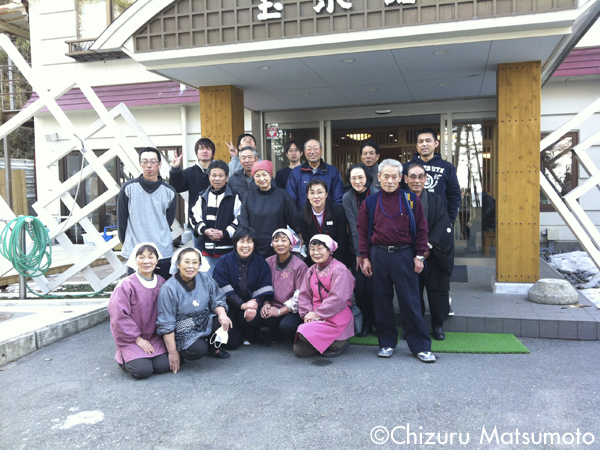
At a kagura lodging – Kamaishi Horaikan hall on tour

The Gongen Dance
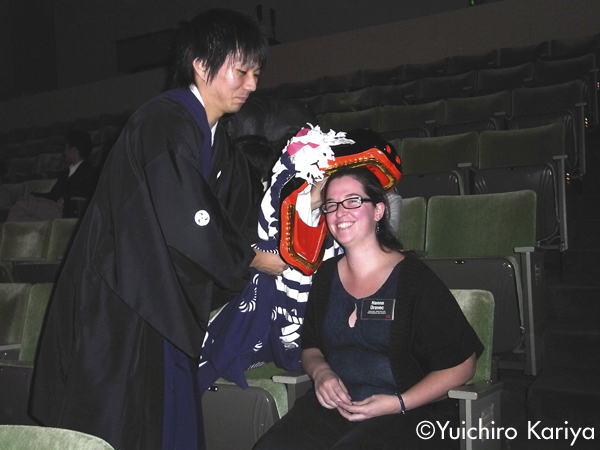
A Mi-katame pose on tour in the USA
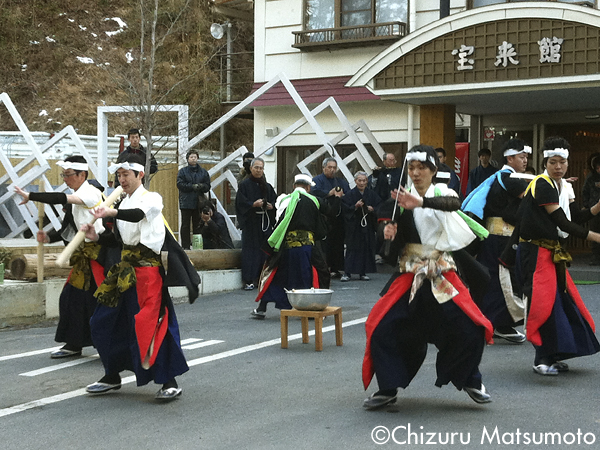
At a kagura lodging – the Maikomi
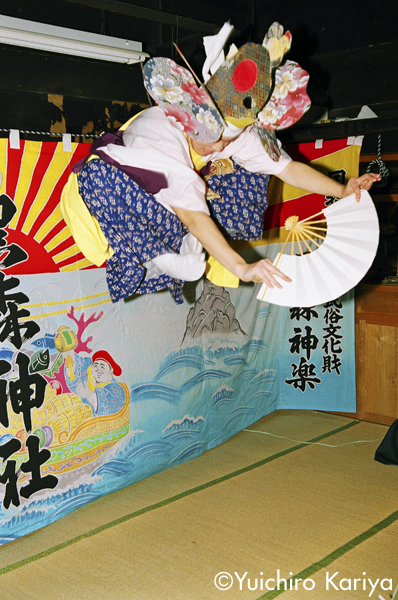
Sakakiba , a dance of celebration at driving off a devil

Yama-no-Kami-mai , the patron deity of people who work in forestry or farming. A representative dance portraying courage and strength.
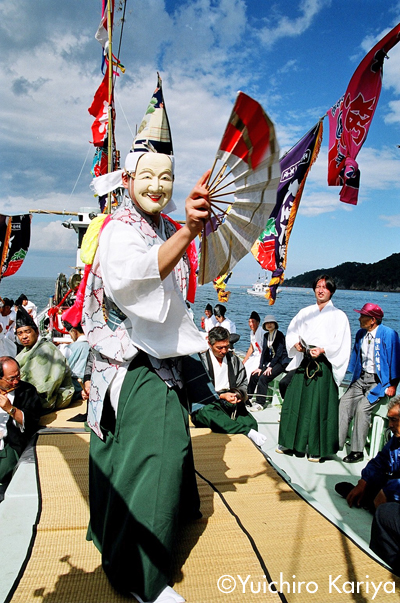
Ebisu-mai , the god Ebisu catches a sea bream in a dance that prays for big catches and safety on the sea for fishermen.
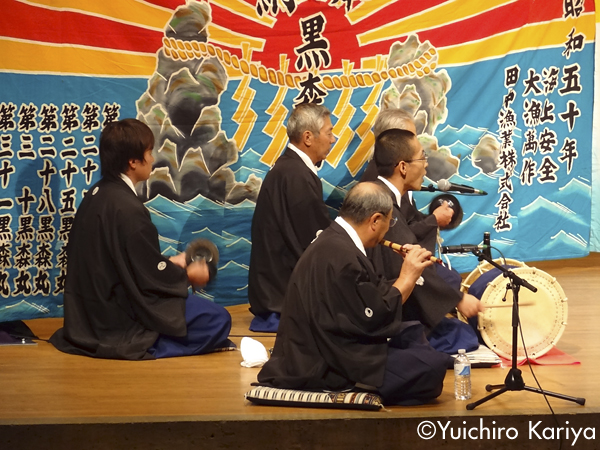
The musicians
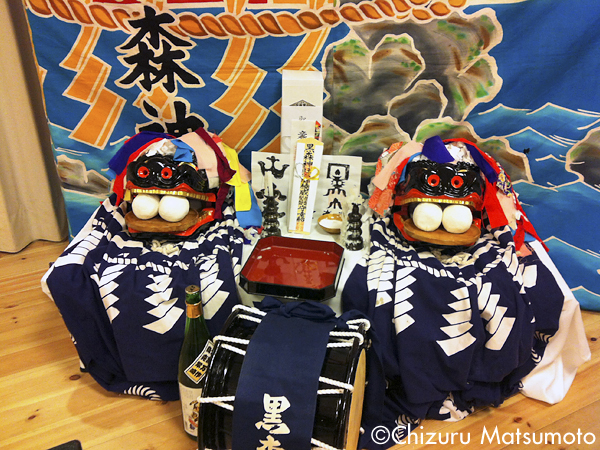
At a kagura lodging – Gongen-sama
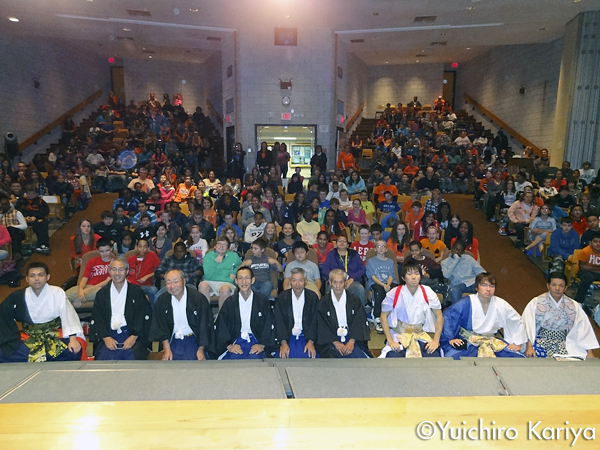
A workshop at an elementary and middle school in Middletown in the USA. (Nov. 20120)
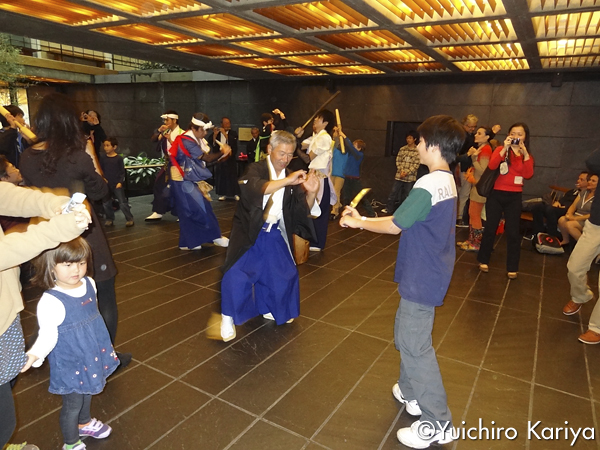
At a workshop in New York, USA (Oct. 2012 at Japan Society, NY)
Related Tags
Hiroki Tanaka
The spirit of traveling Kuromori Kagura ritual performers, two years after the Great East Japan Earthquake and Tsunami

© Yuichiro Kariya
Hiroki Tanaka
Kuromori Kagura performer
Two years have passed since the devastating Great East Japan Earthquake and Tsunami of March 11, 2011. The northeastern Tohoku region that experienced such unprecedented devastation is also a region that has long been known for its rich store of folk arts. Notable among them are the folk arts of Iwate Prefecture, some of which date back a thousand years. One of these is Kuromori Kagura, a tradition of ritual dance and music based in the Kuromori Shrine of the city of Miyako and performed by troupes of performers who travel from village to village over a wide area of the Sanriku coast from Kuji in the north to Ishinomaki in the south a form of spiritual pilgrimage. In 2006, this precious tradition was officially recognized by the national government as an Important Intangible Folk Cultural Asset. However, the March 2011 disaster also dealt a blow that has threatened the future of this serious 400-year-old tradition, and many of the local inns that long welcomed the kagura performers with lodging on their pilgrimage routes were damaged by the tsunami. But, the kagura performers are continuing to tour and perform in order to bring inspiration and courage to the people of the stricken areas. Also, with support from the Japan Foundation and Agency for Cultural Affairs, Kuromori Kagura performers have traveled to Russia, France and the U.S. to perform and show the spirit of Japan’s traditional folk arts and their determination to overcome hardship while giving performances in appreciation of the aid that poured into Japan from people in countries worldwide after the disaster. The folk arts are a pillar of the region that links the people of its communities, and for that reason their revival is vital for the region’s recovery.
Interviewer: Junko Hanamitsu (NPO Kaibunsha producer)

